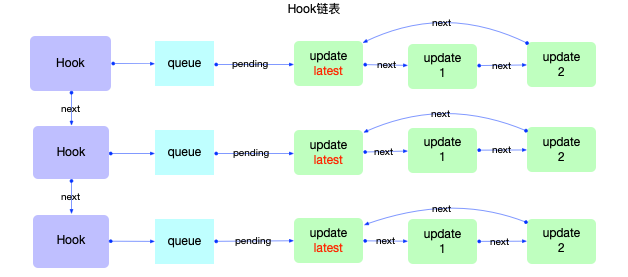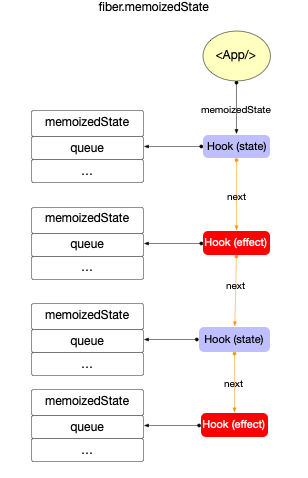阅读图解React笔记8
2022 react本文仅仅是阅读 图解 React 原理系列 的笔记,了解更多内容请查看原文链接。
Hook 原理
Hook 与 Fiber
Hook 最终也是为了控制 fiber 节点的状态和副作用,从 fiber 视角,状态和副作用的相关属性如下:
export type Fiber = {
// 省略其他。。。
// fiber 节点自身状态相关
pendingProps: any,
memoizedProps: any,
updateQueue: any,
memoizedState: any,
// fiber 节点副作用相关
flags: Flags,
nextEffect: Fiber | null,
firstEffect: Fiber | null,
lastEffect: Fiber | null,
};
使用 Hook 的任意一个 API,最后都是为了控制上述这几个 fiber 属性。
Hook 数据结构
在 react-reconciler/src/ReactFiberHooks.new.js,定义了 Hook 的数据结构:
type Update<S, A> = {
lane: Lane,
action: A,
eagerReducer: ((S, A) => S) | null,
eagerState: S | null,
next: Update<S, A>
priority?: ReactPriorityLevel,
}
type UpdateQueue<S, A> = {
pending: Update<S, A> | null,
dispatch: (A => mixed) | null,
lastRenderedReducer: ((S, A) => S) | null,
lastRenderedState: S | null,
}
export type Hook = {
memoizedState: any,
baseState: any,
baseQueue: Update<any, any> | null,
queue: UpdateQueue<any, any> | null,
next: Hook | null,
}
从定义上看,Hook 对象共有 5 个属性:
- hook.memoizedState: 保持在内存中的局部状态。
- hook.baseState: hook.baseQueue 中所有 update 对象合并之后的状态。
- hook.baseQueue: 存储 update 对象的环形链表,只包括高于本次渲染优先级的 update 对象。
- hook.queue: 存储 update 对象的环形链表,包括所有优先级的 update 对象。
- hook.next: next 指针,指向链表中的下一个 hook。
所以 Hook 是一个链表,单个 Hook 拥有自己的状态 hook.memoizedState 和 自己的更新队列 hook.queue。

注意:其中 hook.queue 与 fiber.updateQueue 虽然都是 update 环形链表,尽管 update 对象的数据结构与处理方式都是高度相似,但是这两个队列中的 update 对象是独立的。hook.queue 只作用于 hook 对象的状态维护。
Hook 分类
在 18.2.0 中,共定义了 17 种 Hook 类型:
export type HookType =
| 'useState'
| 'useReducer'
| 'useContext'
| 'useRef'
| 'useEffect'
| 'useInsertionEffect'
| 'useLayoutEffect'
| 'useCallback'
| 'useMemo'
| 'useImperativeHandle'
| 'useDebugValue'
| 'useDeferredValue'
| 'useTransition'
| 'useMutableSource'
| 'useSyncExternalStore'
| 'useId'
| 'useCacheRefresh';
官网上将其分为两个类别,状态 Hook(State Hook)和副作用 Hook(Effect Hook)。
调用函数前
在调用函数前,react 内部还需要做一些准备工作。
处理函数
从 fiber 树构造的视角来看,不同的 fiber 类型,只需要调用不同的处理函数返回 fiber 子节点。所以在 performUnitOfWork -> beginWork 函数中,调用了多种处理函数。
本节讨论 Hook,所以列出其中的 updateFunctionComponent 函数,其源码位置:ReactFiberBeginWork.new.js
// 只保留 FunctionComponent 相关的代码
function beginWork(current: Fiber | null, workInProgress: Fiber, renderLanes: Lanes): Fiber | null {
const updateLanes = workInProgress.lanes;
// 省略其他代码。。。
switch (workInProgress.tag) {
// 省略其他代码。。。
case FunctionComponent: {
const Component = workInProgress.type;
const unresolvedProps = workInProgress.pendingProps;
const resolvedProps =
workInProgress.elementType === Component
? unresolvedProps
: resolveDefaultProps(Component, unresolvedProps);
return updateFunctionComponent(
current,
workInProgress,
Component,
resolvedProps,
renderLanes,
);
}
}
}
function updateFunctionComponent(current, workInProgress, Component, nextProps, renderLanes) {
// 省略其他代码
// 进入 Hook 相关代码,返回下级 ReactElement 对象
nextChildren = renderWithHooks(
current,
workInProgress,
Component,
nextProps,
context,
renderLanes,
);
reconcileChildren(current, workInProgress, nextChildren, renderLanes);
return workInProgress.child;
}
在 updateFunctionComponent 函数中调用了 renderWithHooks,至此 Fiber 与 Hook 产生了关联。
renderWithHooks 函数
renderWithHooks 源码位于 ReactFiberHooks.new.js
export function renderWithHooks<Props, SecondArg>(
current: Fiber | null,
workInProgress: Fiber,
Component: (p: Props, arg: SecondArg) => any,
props: Props,
secondArg: SecondArg,
nextRenderLanes: Lanes,
) {
// 1. 设置全局变量
renderLanes = nextRenderLanes;
currentlyRenderingFiber = workInProgress;
// 清除当前 fiber 的遗留状态
workInProgress.memoizedState = null;
workInProgress.updateQueue = null;
workInProgress.lanes = NoLanes;
// 2. 调用函数,生成子级 ReactElement 对象
// 指定 dispatcher, 区分 mount 和 update
ReactCurrentDispatcher.current =
current === null || current.memoizedState === null
? HooksDispatcherOnMount
: HooksDispatcherOnUpdate;
// 执行函数,其中进行分析 hooks 的使用
let children = Component(props, secondArg);
// 3. 重置全局变量,返回 children
renderLanes = NoLanes;
currentlyRenderingFiber = (null: any);
currentHook = null;
workInProgressHook = null;
didScheduleRenderPahseUpdate = false;
return children;
}
- 调用函数前:设置全局变量,标记渲染优先级和当前 fiber,清除当前 fiber 的遗留状态。
- 调用函数:构造出 hooks 链表,最后生成子级 ReactElement 对象(children)。
- 调用函数后:重置全局变量,返回 children。
调用函数
Hooks 执行流程
所有的 hook 执行流程大体一致:
- FC 进入 render 流程前,确定 ReactCurrentDispatcher.current 指向。
-
进入 mount 流程时,执行 mount 对应逻辑,方法名一般为 mountXXX。
function mountXXX() { // 获取对应的 hook const hook = mountWorkInProgressHook(); // 省略,执行 hook 自身的操作 } // 常见的 useState 对应的 mount function mountState<S>(initialState: (() => S) | S): [S, Dispatch<BasicStateAction<S>>] { const hook = mountWorkInProgressHook(); // 省略其他代码。。。 return [hook.memoizedState, dispatch]; } // 常见的 useEffect 对应的 mount function mountEffectImpl(fiberFlags, hookFlag, create, deps): void { const hook = mountWorkInProgressHook(); // 省略其他代码。。。 } -
update 时,执行 update 对应逻辑,方法名一般为 updateXXX。
function updateXXX() { // 获取对应的 hook const hook = updateWorkInProgressHook(); // 省略,执行 hook 自身的操作 } - 其他情况 hook 执行,依据 ReactCurrentDispatcher.current 指向做不同的处理。
链式存储
查看 ReactFiberHooks.new.js 文件中的 mountWorkInProgressHook
function mountWorkInProgressHook(): Hook {
const hook: Hook = {
memoizedState: null,
baseState: null,
baseQueue: null,
queue: null,
next: null,
};
if (workInProgressHook === null) {
// 链表中首个 hook
currentlyRenderingFiber.memoizedState = workInProgress = hook;
} else {
// 将hook添加到链表末尾
workInProgressHook = workInProgressHook.next = hook;
}
return workInProgressHook;
}
逻辑是创建 Hook 并挂载到 fiber.memoizedState 上,多个 Hook 以链表结构保存。

顺序克隆
fiber 树构造(对比更新)阶段,执行 updateFunctionComponent -> renderWithHooks 时,执行 useState 和 useEffect 在 fiber 对比更新分别对应 updateState -> updateReducer 和 updateEffect -> updateEffectImpl。
function updateWorkInProgressHook(): Hook {
// 移动 currentHook 指针
let nextCurrentHook: null | Hook;
if (currentHook === null) {
const current = currentlyRenderingFiber.alternate;
if (current !== null) {
nextCurrentHook = current.memoizedState;
} else {
nextCurrentHook = null;
}
} else {
nextCurrentHook = currentHook.next;
}
// 移动 workInProgressHook 指针
let nextWorkInProgressHook: null | Hook;
if (workInProgressHook === null) {
nextWorkInProgressHook = currentlyRenderingFiber.memoizedState;
} else {
nextWorkInProgressHook = workInProgressHook.next;
}
if (nextWorkInProgressHook !== null) {
workInProgressHook = nextWorkInProgressHook;
nextWorkInProgressHook = workInProgressHook.next;
currentHook = nextCurrentHook;
} else {
currentHook = nextCurrentHook;
const newHook: Hook = {
memoizedState: currentHook.memoizedState,
baseState: currentHook.baseState,
baseQueue: currentHook.baseQueue,
next: null,
};
if (workInProgressHook === null) {
currentlyRenderingFiber.memoizedState = workInProgressHook = newHook;
} else {
workInProgressHook = workInProgressHook.next = newHook;
}
}
return workInProgressHook;
}
updateWorkInProgressHook 函数的逻辑目的是为了让 currentHook 和 workInProgressHook 两个指针同时向后移动。